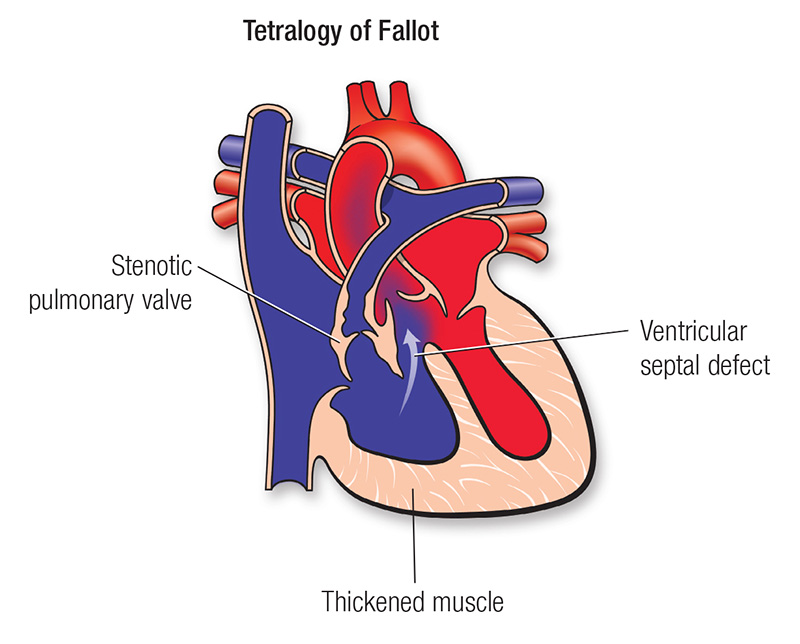
Tetralogy of Fallot is a rare condition caused by a combination of four heart defects that are present at birth
Tetralogy of Fallot is a rare, complex heart defect. It occurs in about 5 out of every 10,000 babies. The defect affects boys and girls equally.
Tetralogy of Fallot is often diagnosed during infancy or soon after. However, tetralogy of Fallot might not be detected until later in life, depending on the severity of the defects and symptoms.
Symptoms may include:
- A bluish coloration of the skin caused by blood low in oxygen (cyanosis)
- Shortness of breath and rapid breathing, especially during feeding or exercise
- Loss of consciousness (fainting)
- Clubbing of fingers and toes — an abnormal, rounded shape of the nail bed
- Poor weight gain
- Tiring easily during play or exercise
- Irritability
- Prolonged crying
- A heart murmur
These symptoms usually appear during the first few weeks of life. In mild TOF cases, symptoms may not appear until much later when the child or young adult becomes more active, placing more demand on the heart. Without treatment, symptoms will persist.
Tetralogy of Fallot is caused by the combination of four heart defects that occur during the growth of the fetus:
- Pulmonary valve stenosis
- Ventricular septal defect
- Overriding aorta
- Right ventricular hypertrophy
After your baby is born, your baby's doctor might suspect tetralogy of Fallot if your baby has blue-tinged skin or if a heart murmur
Your baby's cardiologist will conduct a physical examination and use several tests to confirm the diagnosis.
- Cardiac catheterization —a tube-like instrument is inserted into the heart through a vein or artery (usually in the arm or leg) to detect problems with the heart and its blood supply
- Echocardiogram —a test that uses high-frequency sound waves (ultrasound) to examine the size, shape, and motion of the heart
- Oxygen level measurement- This test uses a small sensor that can be placed on a finger or toe to measure the amount of oxygen in your baby's blood.
- Chest x-ray —a test that uses radiation to take a picture of structures inside the chest
Various medications are often given to relieve symptoms and prevent complications. Tetralogy of Fallot is primarily treated surgically. Surgical options include:
- Intracardiac repair - This open-heart surgery is usually done during the first year after birth. The surgeon places a patch over the ventricular septal defect to close the hole between the lower chambers of the heart.
- Temporary surgery - Occasionally babies need to undergo a temporary surgery before having intracardiac repair.
- After surgery - Sometimes blood flow to the lungs may still be restricted after intracardiac repair. Infants, children or adults with these complications might require additional surgeries. In some cases, the pulmonary valve might need to be replaced.
Complications can continue throughout childhood, adolescence and adulthood for people with tetralogy of Fallot.
BestHeartSurgery is a comprehensive information portal that gives both the common man and medical professionals.

